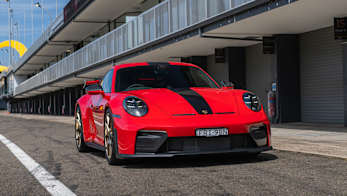If you live in Sydney, or near a Hertz, you've probably seen a lot of Polestar 2s as rental cars or Ubers, flying in the face of the brand's "sporty and individualistic" positioning in the market. But according to its local managing director, Samantha Johnson, fleet sales are only a small proportion of overall sales.
Instead, Johnson suggested that novated leasing was one of the more popular methods for individuals to get their hands on a Polestar 2, and private sales remained strong for a more even split between these three primary ways the car is sold - fleet, lease, and buy.
Buyer demographics are also said to be primarily from the luxury realm, although new customers to the brand are also coming out of other vehicles as a way to move up into their first EV or premium car, or even just because they agree with the sustainable message Polestar pairs with its vehicles.
But what is behind this rideshare push as hundreds of Polestars are driving around - in Sydney in particular - with an Uber sticker on the rear window? Two factors play a part.
The first is the partnership between rideshare vehicle leasing service Splend, and Uber. The companies partnered up in October of 2022 to put 500 Polestar 2s on the road via a "flexi-own plan" where rideshare drivers pay a fixed fee for a Polestar 2 with a view to owning the car after several years.
The drivers not only get access to a brand new car without what Splend says is "the need to traditionally finance" thanks to a subscription model, but Uber's contribution to the service is to reduce its fee for participants by 50 per cent (said to be worth up to $6000 annually).
Uber is also set to imminently launch a new ride category in Australia, able to be chosen when ordering a ride, dubbed "Comfort Electric". This category will offer riders the opportunity to guarantee they're driven in a zero-emissions vehicle, as opposed to the current "Green" category, which mixes pure electric vehicles in with hybrids like the ever-popular Toyota Camry.
.jpg)
"Comfort Electric" has been available overseas for some time, and will allow drivers to also charge slightly more for zero-emissions rides.
The second factor is the previous NSW government's funding plan for zero-emissions vehicles, of which Splend was a recipient, as well as the current federal government's $20 million concessional finance provided to the company to "double the number of EVs it offers on its flexible subscription plans".
This funding plan is intended to allow Splend the ability to double its fleet to 1000 zero emissions vehicles. As part of a statement in June of 2023, Minister for Climate Change and Energy Chris Bowen said: "Rideshare vehicles cover five to six times the distance of an average privately-owned car. This is about making cleaner, cheaper-to-run cars more accessible for rideshare workers."
"By encouraging more EVs in rideshare fleets, we'll be able to reduce transport emissions in Australia. Fleets make up around half of all vehicle sales, so this initiative is a big deal, as well as boosting the market for second-hand EVs."
Sounds great. More zero emissions vehicles travelling more kilometres. But what's the catch? While it's great drivers can get into an EV without the need to apply for finance or stump up a large upfront cost, we'd recommend people do the sums - because at the end of the day, the driver still pays.
In NSW where the maximum discount for drivers is applied thanks to the additional state funding, a Polestar 2 Standard Range costs $419 per week on Splend's flexi-own five-year plan. The minimum term is 52 weeks, but to actually ‘own' the car, you'd need to multiply that by five across the plan.
When you add the $990 setup fee this car, which normally costs $63,900 (which is actually $60,900 in NSW thanks to a state-based EV discount), has actually cost the driver $109,930. If we're feeling generous and apply the full theoretical Uber fee discount of $6000 a year (for three years, because the fine-print notes it ends in 2025), we still end up with $91,930.
.jpg)
At the end of the program, drivers pay a $1 fee and stamp duty to transfer the car into their name, although it's worth noting that the car will have somewhere between 200,000 and 300,000 on the clock at that time.
Does that seem like a good deal when a hybrid Camry can be had new from $36,820 (much less than $91,930 even with financing)? A mitigating factor is the Toyota sedan is currently attracting a 12 month waiting list.
There are conditions, too. Drivers are limited to 1000km a week (although they can pay to extend this), and must ask Splend for permission to take the car on a longer journey, however they are able to take a break from the vehicle and payments for up to four weeks. Regardless, they'll need to be driving a decent amount constantly to at least cover the $419 weekly fee.
So, yes, drivers ultimately pay for this explosion of new zero-emissions vehicles on the roads, but there's an argument to be made that the scheme puts EVs in these driver's hands rather than hybrid or pure combustion cars instead, with Splend's finance-free pathway to own and the government tipping in a generous amount, too.
Meanwhile, the heavily updated rear-wheel drive Polestar 2 has just hit our shores, with the Long Range Single Motor ($74,400) and Long Range Dual Motor ($76,400) attracting reasonable six- to eight-week delivery times, with the Standard Range ($67,400) set to begin production in October for a slightly later arrival.
It remains to be seen if the new and more expensive model will be taken up at the same rate by ride-share services as the outgoing MY23 version.













.jpg)

.jpg)
.jpg)


.jpg)

.jpg)

.jpg)
.jpg)
.jpg)


.jpg)

